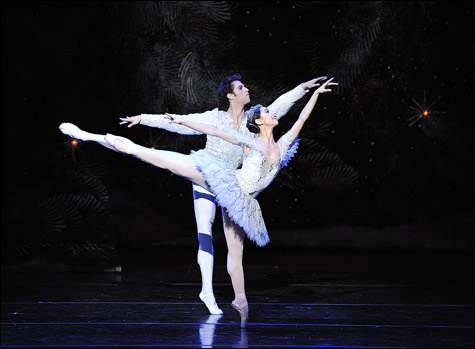
LET IT SNOW Erica Cornejo and James Whiteside supplied some of the opening-night fireworks. |
When you've seen every Boston Ballet Nutcracker for the past 20-odd years, and reviewed most of them, it can get a little hard to locate the magic. Then again, when you survey other Nutcrackers around the world — I'm thinking in particular of the saccharine San Francisco Ballet entry that turned up on PBS's Great Performances last Christmas — you appreciate that there's no place like home, and not many that are as good.
The only novelty about this year's edition (at the Opera House through December 27) of the company's holiday extravaganza (the "42nd annual production," the program tells us, though since the first one was in 1965, the math doesn't quite add up) is that the Opera House is now Boston Ballet's permanent home, and with the reconstruction of the Opera House pit, music director Jonathan McPhee and the Boston Ballet Orchestra sound better than they ever did in the oversized Wang Theatre. They also sound faster than I ever remember. This is a cogent, compelling Nutcracker, but sometimes at the cost of characterization.
You could, of course, argue that characterization needn't count for much in this holiday moneymaker, a work that, worldwide, is seen by more people (and way more children) than any other ballet. But as the story that's the basis of The Nutcracker — E.T.A. Hoffmann's 1816 novella Nutcracker and Mouse King — makes clear, you can have adult content and magic. There's no want of stage wizardry here: audiences will be left scratching their heads when Uncle Drosselmeier covers Fritz with a tablecloth and causes him to levitate before snatching the cloth away to reveal . . . nothing.
There's some terpsichorean magic, as well, though I wish there were more. On opening night last Friday, the company gave us Lia Cirio as the Sugar Plum Fairy and Pavel Gurevich as her Nutcracker Cavalier. (This is one of those laudable versions where the first-act Nutcracker turns into the second-act Cavalier.) I was taken with the way Cirio, who's returned to the company after a year with the Trey McIntyre Project, pointed her celesta accompaniment in Sugar Plum's solo variation, but not with her momentum-less manège, or her fixed smile, or her failure to look at her partner. Gurevich could have used some encouragement: his jumps were big but also tentative, and his own manège was a modest one. He was promoted to principal this year after two spectacular performances as the Prince in The Sleeping Beauty last May, so the potential is there.
The opening-night fireworks came instead from Erica Cornejo and James Whiteside as Snow Queen and King and from Kathleen Breen Combes and Jaime Diaz in the Arabian divertissement. Cornejo seemed to grow lighter and more expansive with every cymbal crash, and Whiteside's rough-hewn exuberance complemented her technical precision. Breen Combes gave Arabian the sensuousness it needs but rarely gets (in this or any other production) by continually readjusting the angle of her body to Diaz's — she may come when he claps his hands, but she's not exactly his love slave. There was a fleet — almost outrunning McPhee's tempos — Dew Drop from Misa Kuranaga and a spirited and unstereotyped Chinese variation from Dalay Parrondo and Isaac Akiba. Whitney Jensen was a ditsy blonde Columbine; Josephine Pra and Altan Dugaraa as Clara's grandparents got the most out of their comic polka. Jeffrey Cirio brought some pirouetting panache to the busking Young Man (this year finally credited in the program) in the prologue; he was also an unusually energetic shepherd in the Pastorale variation.